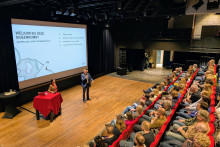The percentage is much higher than in previous years. What contributed to this?
Loorbach: ‘Our new Open Access policy, which is officially active since December 2021. There are two routes outlined in the policy. First, the preferred route: publishing open access immediately with a license for reuse. If that is not possible, there is a back-up option – opening up the publication later on. The Dutch Copyright Act specifies that, after a reasonable amount of time, researchers can open up their research regardless of the publisher’s rules. On top of that, the new policy introduced the ‘opt-out’ procedure. That means we will open up the scientist’s work, unless they tell us not to. So far, only two people used this option this year. All this contributed to the big leap.’
Graph provided by UT Team Open Access: www.utwente.nl/openaccess
The new policy aims to ensure that all academic publications at the UT are freely accessible in 2023. Will we get to 100% before the end of that year?
‘That is not really feasible. Firstly, the yearly numbers are always lagging behind, because they are based on what’s registered in Pure (Elsevier’s research information management system, ed.) and scientists often upload their work to Pure months after it is published. The numbers for 2021 are only available now, for example. When we look at the numbers for 2021, 3% of articles were not freely accessible. 1% is simply because PDFs were not attached to the publications. If articles are first published behind a paywall, authors might not even have the PDF at first. For the remaining 2%, our policy is not applicable. Our procedures only apply to employees on UT payroll. They currently don’t apply to emeritus professors and external PhDs, for example. That’s why a complete 100% open access isn’t really possible.’
How is the UT doing compared to other universities?
‘I don’t have the numbers for all individual universities, but the average in the Netherlands is 83% open access. The UT and the University of Groningen are both at 97%. We actually used Groningen’s opt-out regulations as the baseline for our own, so we can see it is a very effective policy.’
What are the next steps?
‘We want to keep improving. Most importantly, we’d like everything to be published through our preferred route – immediately open access with a license for reuse. We want to urge scientists to upload all their publications to Pure and we are also looking into extending our regulations, so that they also apply to emeritus scientists and external researchers. We will look at the situation in each faculty in more detail and see what steps can be taken to increase the percentage of the preferred route, agreements with publishers and so on. Our information specialists will help faculties to look into all the possibilities. Reaching 97% is something we should be incredibly proud of, but we should also not think that we are done.’









